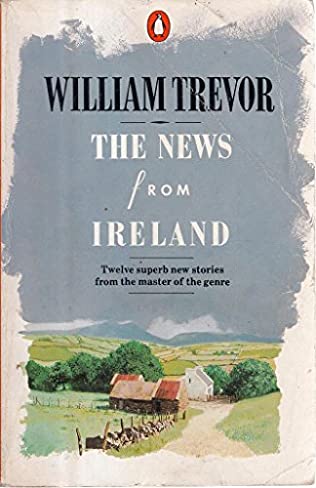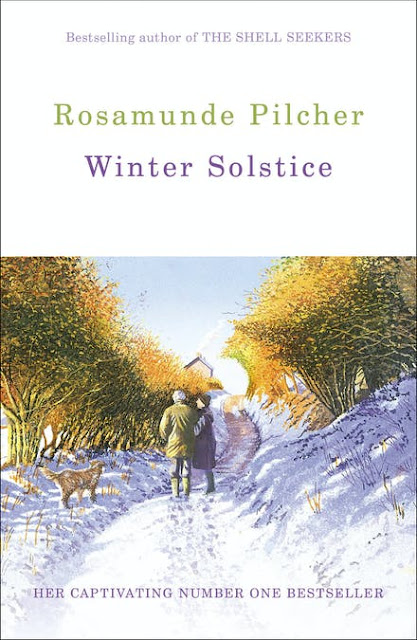20 Books of Summer: The News from Ireland by William Trevor
At fifty-nine she was on her own, the widow of the O’Neill who had inherited the town’s coal business, who had started, as an enterprise of his own, the toy factory. (Bodily Secrets)
I think the skill lies in observation; Julian Barnes says* that Trevor used to enjoy sitting on park benches, eavesdropping on people's conversations, but he always moved on before they reached the end of their stories because he only needed an idea. We recognise those people, those places, because they are known to us. I may never have been in Florence, nor indeed at the crossroads at Drumgawnie which provide the location for The Property of Collette Nervi, but Trevor takes me there; I can imagine exactly what each is like; I can see Dolores Mullally lifting the net curtain to get a better view of the French tourists outside her mother’s shop at those crossroads, or Mrs Faraday in her rust red suede coat, smoking a cigarette as she attempts to pick up the English guidebook writer in Cocktails at Doney’s.
The stories in The News from Ireland are set variously in Italy, England and Ireland itself. On holiday in Venice with his adult daughter Verity (On the Zattere), Mr Unwill, widowed, bluff, and apparently genial, presses people for conversation, attempts to flirt with young German tourists, avoids paying for drinks, his inappropriate behaviour trying Verity’s patience as she attempts to come to terms with problems in her own life. Towards the end of their trip these two sad people almost have a conversation about what is really going on, about his grief for his dead wife and her bitterness for the years she has wasted pursuing a married man – but as is so often the case, it comes to nothing;
The conversation was over, its loose ends hanging ; each knew they would never be picked up.Many of the stories are about women, often disappointed and/or desperate (Her Mother’s Daughter, The Wedding in the Garden, Lunch in Winter.) In the title story, set in 1847, an English governess, Anna Heddoe, comes to work for the Pulvertafts, a wealthy English family who have inherited an Irish estate. It is the time of the potato famines, people are dying. Despite Mr Pulvertaft’s efforts to provide work for the local men, the servants in the house resent and despise him just as they do Miss Heddoe. Mr Pulvertaft, while living a life of privilege (champagne is served at his daughter’s wedding while local women feed grass to their babies), wants everyone to be happy, and is shocked to find that his workers are not grateful. Miss Heddoe is distressed to learn that the ‘stigmata’ found on a local baby, far from being a miracle are more likely to have been inflicted by the destitute, starving parents. The baby dies;
Seven other children have been buried in that family and the two sets of grandparents.’Sure, didn’t they see the way things was turning?’ was how Miss Fogarty put it ‘Didn’t they see an RIP all ready for them, and wouldn’t they be a holy family, with the baby the way they’d made it, and wouldn’t they be sure of preservation because of it?
The death of the baby is not discussed at the family dining
table,
Nobody spoke of the stigmata because the subject was too terrible for conversation.
The work that Mr Pulvertaft provides is the construction of
a pointless road to encircle the estate. Nothing is without meaning in a
William Trevor story.
Phelan who brought the bread,…..the Mitchellstown Cheese man….Jimmy Reilly who brought the bacon.
The Christmas shopping day in Rossaphin, with a lift
organised by the parish priest; the meal in Love’s Café.
The lost handbag continues to be important to the story four
years after its disappearance, when it tells Dolores something she already
suspects about the man she is to marry.
My favourite story in this collection is The Virgins. It is
1941; an English girl, Laura, is sent to stay with her mother’s Irish schoolfriend
to escape the bombings (the war being referred to in neutral Ireland as ‘the Emergency’.)
There she joins forces with the beautiful daughter of the Heaslip family, Margaretta;
together the two girls roam the town, sharing jokes about the eccentricities of
the local people, seeing every film that comes to the town’s cinemas, making up
stories about themselves and everyone else. As always, Trevor can recreate the
atmosphere of a place and a time with so few words. The names of the shops;
Murphy’s, O’Connors, Mrs Finney’s....Shannon's Medical Hall, the Home and Colonial
And of the people; Wiry Daly ‘from the hardware’s', Mattie
Devlin, the gardener who refuses to grow spinach or peas, and who brings Margaretta’s doctor father’s car to the front of the house for him each
morning. Mrs Eldon who makes her lips seem larger with the outline of her
lipstick. [In many ways the story reminded me of Maeve Binchy’s wonderful Light
a Penny Candle, which is set in much the same era and which also sees a young
English girl sent to live with an Irish family.]
For the purposes of the plot, we do not need to know that Mattie will only grow turnips, or that the soup served at lunch is Crosse and Blackwell's, but without these little snippets the story would be so much less, the characters so much less interesting.
Margaretta sees in Laura a kindred spirit;
'You can’t find friends in a town the like of this' Margaretta had said. 'Well I mean you can, you know, only it’s different….the girls in the town want to be nuns and things. They (don't) go in for finding things funny'…..Sometimes the very sight of people made (Laura and Margaretta) laugh.
When the war ends, Laura returns to London, but she is so miserable
there,
It is so drab…I haven’t had an egg for months
that her mother sends her back to Ireland, the friendship is
resumed – now with bicycles that allow the girls to escape into the countryside –
and the summer is idyllic, until they are asked by Mrs Heaslip to visit the wealthy
de Courcy family and meet the invalid adult son, Ralph. This meeting sets off
a chain of events that, two years on, causes the girls’ friendship to shatter.
The story is alive with the details of Irish small town life;
the nuances of speech, the Punchestown race meetings, the proud talk about children working
in America, the sergeant who has left the army because he cannot learn the
Irish language and will therefore be demoted. The conclusion is both poignant
and perfect, as it reminds us how one tiny betrayal, even an imagined betrayal,
can change the course of lives.
WB Yeats once (possibly) said,
Being Irish, he had an abiding sense of tragedy, which sustained him through temporary periods of joy.
This could equally well be said of William Trevor, whose quiet, touching, discreet stories focus above all on the ultimate sadness of the human heart.
The News from Ireland by William Trevor was published by The Bodley Head in 1986, most stories having previously appeared in The New Yorker, the Irish Times, and elsewhere. The collection was republished by Penguin in 1987.
Image of Home and Colonial, Waterford, 1910: National Library of Ireland on The Commons - Flickr: May 10, 1910, Public Domain, https://commons.wikimedia.org/w/index.php?curid=31147366
Image of William Trevor: The New Yorker
Image of the Zattere, Venice: visitvenezia.eu
*The Guardian, 19 May 2018






Comments
Post a Comment